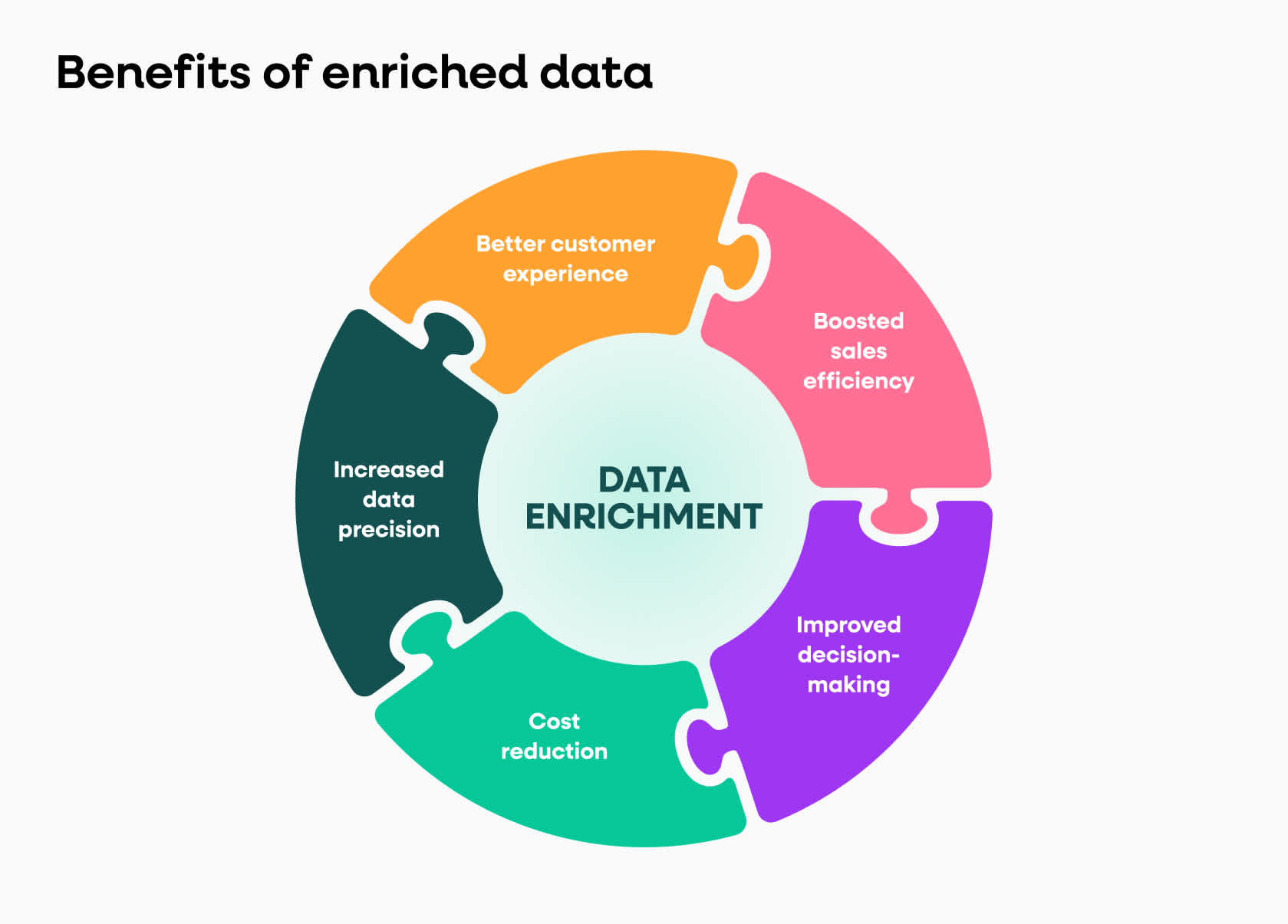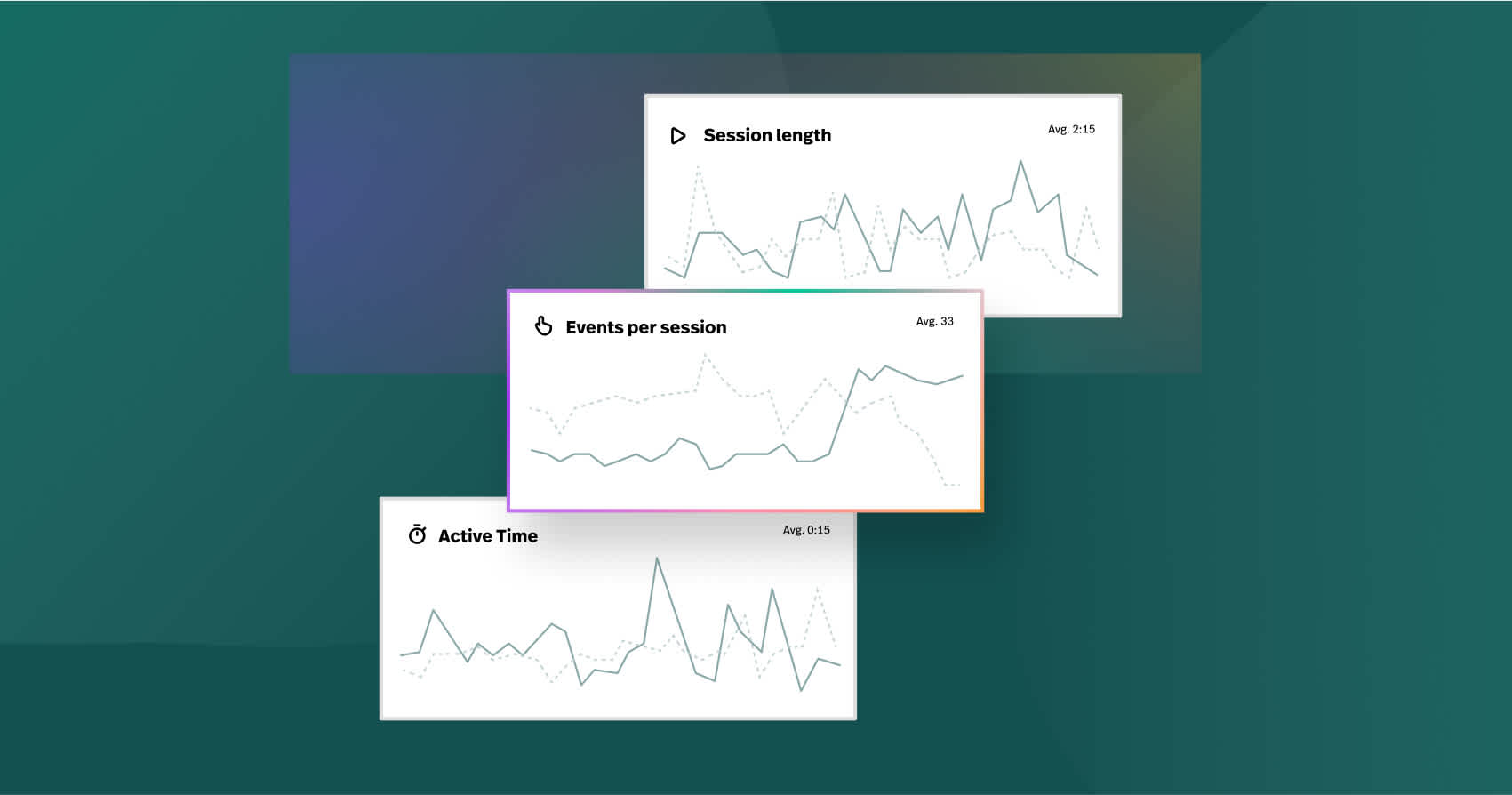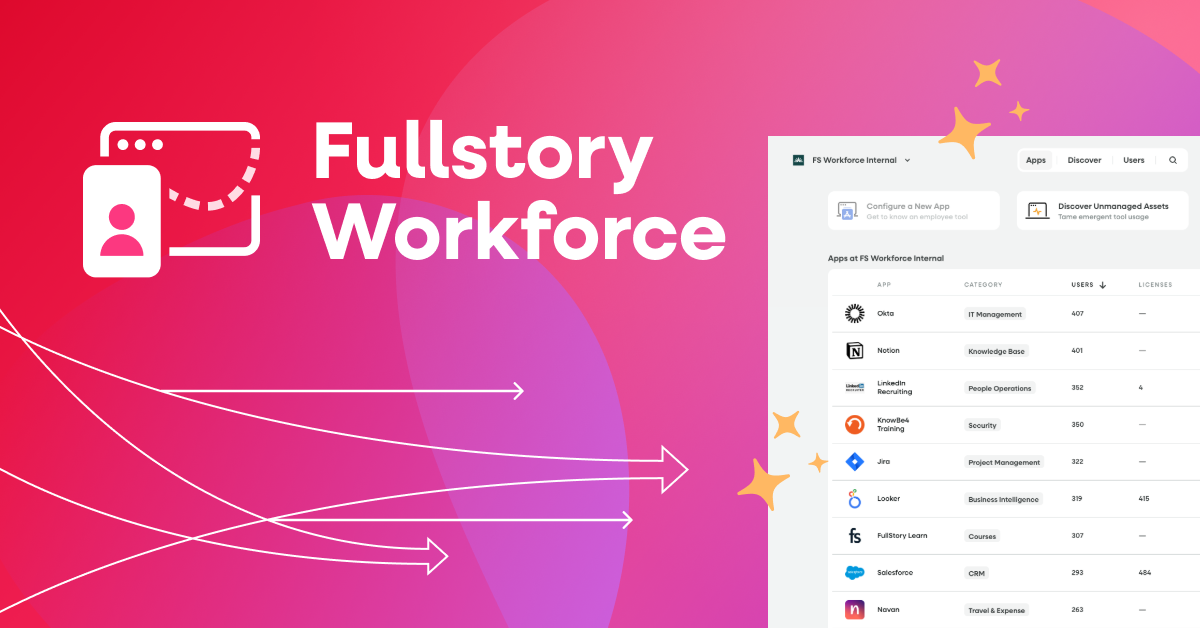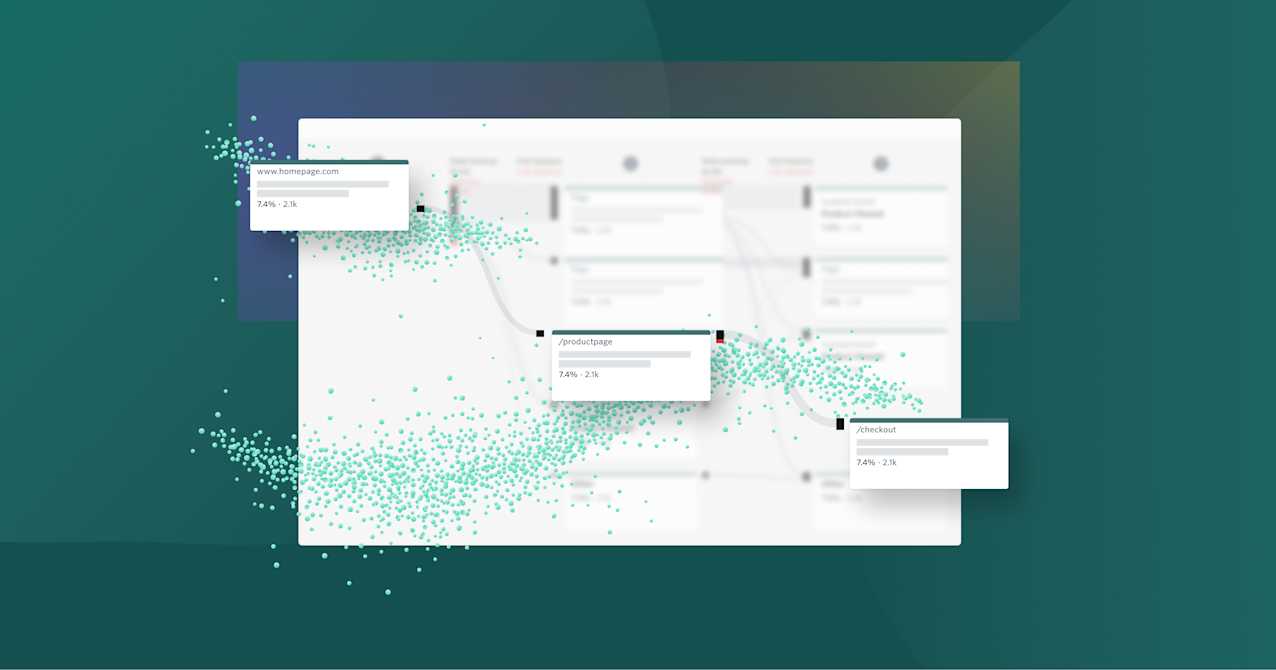Data enrichment gives your customer data a game-changing boost.
Or, in other words, sprucing up the information your business or organization uses. It's not just about adding more data; it's about wisely mixing in information from other sources with what you already have. This approach sharpens your insights, leading to smarter, more informed decisions.
It has a hands-on role in refining business processes.
Take marketing teams, for instance: they dive into enriched data to decode customer preferences, enabling them to design campaigns that hit closer to home. And in security, the depth provided by enriched data sheds light on potential threats, assisting in fraud deterrence and strengthening cybersecurity protocols.
Data enrichment isn't about data quantity, but rather amplifying the value of your existing information, ensuring it delivers more punch for your business operations
Key takeaways:
Data enrichment is the process of enhancing raw data by merging it with additional information from various sources to improve its accuracy and completeness.
The process can improve decision-making and operational efficiency in various business functions.
Enriched data supports personalized marketing strategies and strengthens security measures.
What is data enrichment?
Data enrichment is the process of augmenting existing datasets with relevant additional details from various sources, transforming raw data into a comprehensive asset for informed decision-making and deeper insights.

It's crucial for businesses as it significantly enhances data utility, driving strategic planning, customer insight, and operational efficiency by providing a richer, more actionable information base.
Key components of data enrichment include:
Verification: Ensuring data is current and accurate.
Supplementation: Adding missing or complementary data.
Integration: Merging data from various sources to create a more comprehensive dataset.
The role of data sources
The quality of the sources used determines the success of data enrichment. Two sources can be used to enrich data, including:
Internal data sources: Data already within the company's domain, like transaction histories or customer feedback.
External data sources: Accredited third-party data, which often includes demographic information, economic indicators, or industry trends.
Both types of sources contribute distinct layers of information, enabling a company to build a more rounded and intricate profile of their customers or business environment.
Specialized tools are required in customer data enrichment. Those that can handle vast amounts of information and support the integration with existing systems, like CRMs, to streamline workflows and data management. Companies can significantly enhance data quality and, as a result, the overall decision-making process by carefully selecting reputable data providers.
5 benefits of enriched data
Data enrichment enhances the quality and utility of business data, yielding some strategic benefits.
Better customer experience: Improved data offers deeper insight into customer behavior which enables more customized experiences.
Boosted sales efficiency: Sales teams can work more efficiently using enriched data, securing high-quality leads and improving sales targets.
Improved decision-making: A solid analytical base provided by enriched data supports well-informed decision-making. More comprehensive and precise data helps businesses pinpoint opportunities more efficiently.
Cost reduction: The financial toll of low-quality data on businesses is significant. By cleansing and updating their data, businesses can minimize mistakes and cut down on expenses related to inaccurate data.
Increased data precision: Adding further context to existing data enhances the precision and completeness of business data, facilitating more successful outcomes from data-driven decision-making.

Data enrichment examples
Data enrichment involves adding layers to the existing information to give it more depth and utility.
For instance, building a contact list is significantly bolstered by data enrichment when bare-bones datasets like emails and phone numbers are augmented with details such as social media profiles or purchasing history.
Customer segmentation is another example where customer data enrichment plays a large role for marketers who subdivide their audience into more focused groups. Basic demographic information is enriched with behavioral data, enabling more targeted and effective campaigns.
Enriching data with industry, number of employees, and annual revenue can provide B2B sales teams with invaluable insights. They can then tailor their sales approach according to the size and industry-specific needs of the company.
Enhancing data by integrating additional details from external sources is key to strengthening efforts against fraud. This allows companies to compare user-provided data against external databases, enabling them to more accurately flag and investigate suspect transactions.
Types of data enrichment
Several types of data enrichment exist, but the most commonly encountered include:
Demographic: Enhances customer profiles with socio-economic data
Examples: age, gender, income, education, marital statusGeographic: Appends location-based information to data sets
Examples: country, city, state, region, street addressFirmographic: Defines datasets with organizational characteristics
Examples: company size, industry, revenue, performanceBehavioral: Includes data about customer interactions
Examples: purchasing habits, engagement level, user statusTechnographic: Enriches data with technology-related insights
Examples: device type, operating system, software, adoption stagePsychographic: Involves appending lifestyle attributes
Examples: lifestyle, interests, values, personality, opinions
Executing data enrichment
Executing data enrichment involves systematic steps to enhance the quality and value of your data set. Using the right tools is essential to ensure information is accurate and actionable.
Data enrichment techniques and tools
Effective data enrichment relies on using various tools. Businesses often turn to sophisticated software that can automate the incorporation of external data sources to augment internal datasets. For instance, CRM systems are frequently enhanced with such tools, allowing for the seamless integration of additional data points that can refine customer profiles.
Techniques for customer data enrichment include:
Algorithmic matching with third-party data
Append procedures to add missing information
Automation mechanisms to streamline the enrichment process
By applying these techniques, companies can maintain data accuracy and a high level of data integrity across their operations.
Data cleansing processes
Before enrichment, data cleansing is imperative to remove errors and inconsistencies from your dataset. Data cleansing activities often involve:
Identifying and correcting inaccuracies or duplications
Verifying data relevance and timeliness
The goal of these processes is to establish a clean foundation, which is a critical data enrichment best practice. It helps ensure that the enrichment phase adds true value rather than compounding existing data issues.
Integration into business processes
Ultimately, the integration of enriched data into business processes is what turns raw data into strategic business intelligence. This can only be achieved with solid data governance protocols in place, ensuring that data management aligns with organizational objectives. Elements to consider include:
How data flows between systems, such as from enrichment tools to a CRM
The role of automation in maintaining and updating data
Ensuring compliance with data protection regulations
A thoughtful approach to integrating enrichment and data governance magnifies the benefits of enriched data, leading to better decision-making and better business strategies.
Leveraging enriched data
In order to thrive, companies need to harness customer data to create personalized experiences and inform strategic decisions.
Enriched data provides an accurate view of customer profiles, facilitating better segmentation, better marketing strategies, and ultimately, increased profitability.
Customer data utilization
Businesses utilize enriched customer data to gain actionable insights into customer behavior. Through detailed customer profiles, companies can create customer segmentation strategies. This targeted approach leads to personalized experiences, enhancing customer relations and boosting customer engagement.
Profile accuracy: Ensuring data is both complete and accurate.
Segment actionably: Unique segments based on enriched data for specific targeting.
Driving better business decisions
Enriched data informs data-driven decision-making. Executives and managers now back their choices with solid data points, from predicting market trends to anticipating consumer needs. This strategic advantage is pivotal in staying ahead of the competition.
Market adaptation: Adjust strategies promptly by observing market changes.
Revenue growth: Identify opportunities for up-selling and cross-selling.
Enhancing customer interactions
With enriched data, companies tailor interactions in every step of the customer experience. It's about providing relevance and continuity across all channels.
Personalization is not a buzzword; it's a strategy powered by rich, multi-dimensional data that translates into memorable customer experiences.
Consistent engagement: Engage with customers consistently and meaningfully.
On-point interaction: Interact at the right time with the right message.
Through leveraging enriched data, companies create a robust framework for sustaining growth by fine-tuning their approach to customer data, driving actionable business decisions, and continuously enhancing customer interactions.
Best practices for data enrichment
Following best practices is essential for organizations to ensure accuracy, reliability, and relevance during enrichment activities.
Consider these important guidelines:
Set specific goals: Determine clear objectives for data enrichment, like enhancing the accuracy of customer profiles with measurable targets.
Ensure source quality: The quality of enriched data directly depends on the credibility of the sources. Validate them against trusted external data.
Clean data regularly: Data enrichment should be a continuous effort of cleaning, updating, and verifying to keep data quality high.
Add valuable data: Prioritize data that adds significant insight and value, such as behavioral patterns to refine marketing tactics.
Automate: Use enrichment tools to simplify and automate processes, increase efficiency, and minimize errors.
Protect user privacy: Adherence to data protection laws is crucial. Ensure your data enrichment processes comply with legal standards and respect user privacy.
By following these guidelines, organizations can leverage data enrichment to its full potential and make well-informed decisions.
Challenges and considerations
Throughout the data enrichment process, organizations often encounter challenges that demand a strategic approach to both data integrity and legal compliance. The path to achieving success involves maintaining data that is both accurate and of high quality, compliance with legal standards, and proactively managing any risks that might arise.
Maintaining accurate, quality data
Issues with data quality can significantly reduce efforts of data enrichment. It's crucial to have regular checks in place to avoid data inconsistencies that might result in poor business decisions. Paying close attention to the freshness and dependability of the source data is essential for keeping the enriched data accurate.
Consistency: Ensuring uniform data standards and formats across the dataset.
Currency: Regular updates to keep the data relevant and timely.
Reliability: Verification against authoritative sources to confirm the data's validity.
Compliance and risk management
Understanding and adhering to the varying privacy laws and regulations, which differ by location and sector, is essential for businesses. They must implement risk management strategies to address potential data breaches or misuse.
Compliance: Strict observance of GDPR, CCPA, and other data protection regulations.
Risk management: Defined protocols for data security and breach response.
Unlocking the Power of Data Enrichment
Data enrichment transforms the playing field for businesses looking to elevate their data strategies.
It goes beyond stuffing databases with vast amounts of data, rather it involves a strategic selection and validation of information against trustworthy sources.
And the magic of customer data enrichment doesn't stop there.
It's a large player in better understanding your customers, creating personalized experiences to meet their needs, and making choices that are not just good, but great. And let's not forget the tools and tech that can take the grunt work out of data management. Automating the mundane parts means you can focus on the cool stuff: digging into that data to discover gems that drive innovation and growth.



